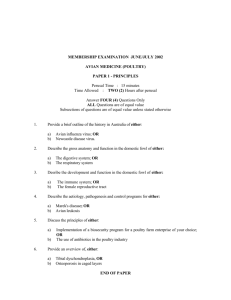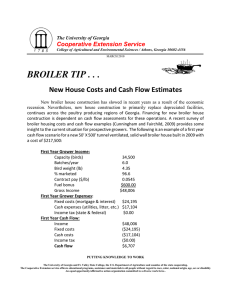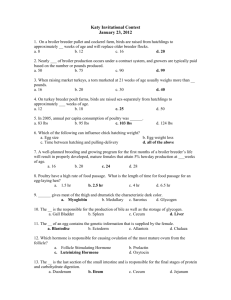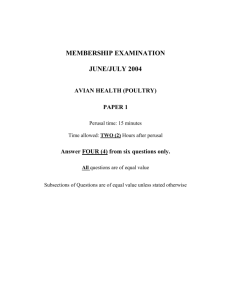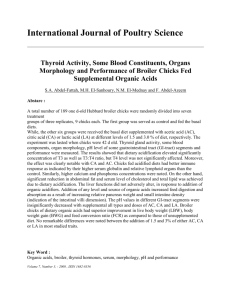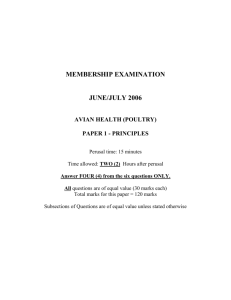Document 13161499
advertisement
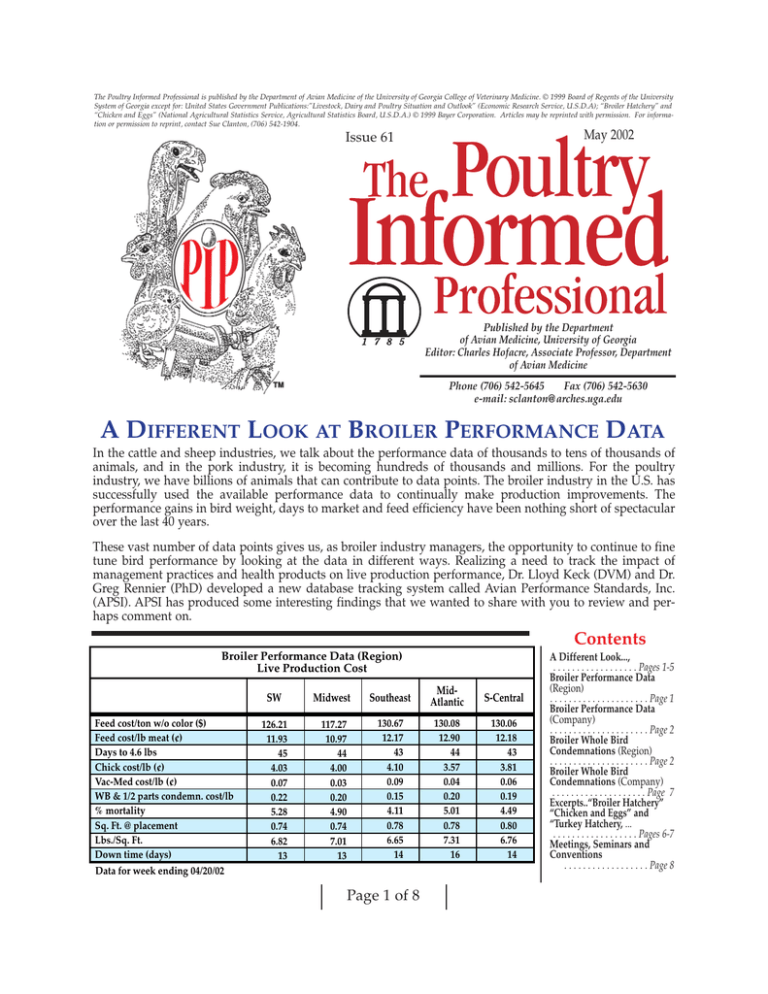
The Poultry Informed Professional is published by the Department of Avian Medicine of the University of Georgia College of Veterinary Medicine. © 1999 Board of Regents of the University System of Georgia except for: United States Government Publications:”Livestock, Dairy and Poultry Situation and Outlook” (Economic Research Service, U.S.D.A); “Broiler Hatchery” and “Chicken and Eggs” (National Agricultural Statistics Service, Agricultural Statistics Board, U.S.D.A.) © 1999 Bayer Corporation. Articles may be reprinted with permission. For information or permission to reprint, contact Sue Clanton, (706) 542-1904. May 2002 Issue 61 Published by the Department of Avian Medicine, University of Georgia Editor: Charles Hofacre, Associate Professor, Department of Avian Medicine Phone (706) 542-5645 Fax (706) 542-5630 e-mail: sclanton@arches.uga.edu A DIFFERENT LOOK AT BROILER PERFORMANCE DATA In the cattle and sheep industries, we talk about the performance data of thousands to tens of thousands of animals, and in the pork industry, it is becoming hundreds of thousands and millions. For the poultry industry, we have billions of animals that can contribute to data points. The broiler industry in the U.S. has successfully used the available performance data to continually make production improvements. The performance gains in bird weight, days to market and feed efficiency have been nothing short of spectacular over the last 40 years. These vast number of data points gives us, as broiler industry managers, the opportunity to continue to fine tune bird performance by looking at the data in different ways. Realizing a need to track the impact of management practices and health products on live production performance, Dr. Lloyd Keck (DVM) and Dr. Greg Rennier (PhD) developed a new database tracking system called Avian Performance Standards, Inc. (APSI). APSI has produced some interesting findings that we wanted to share with you to review and perhaps comment on. Contents Broiler Performance Data (Region) Live Production Cost Feed cost/ton w/o color ($) Feed cost/lb meat (¢) Days to 4.6 lbs Chick cost/lb (¢) Vac-Med cost/lb (¢) WB & 1/2 parts condemn. cost/lb % mortality Sq. Ft. @ placement Lbs./Sq. Ft. Down time (days) SW Midwest Southeast MidAtlantic S-Central 126.21 11.93 45 4.03 0.07 0.22 5.28 0.74 6.82 13 117.27 10.97 44 4.00 0.03 0.20 4.90 0.74 7.01 13 130.67 12.17 43 4.10 0.09 0.15 4.11 0.78 6.65 14 130.08 12.90 44 3.57 0.04 0.20 5.01 0.78 7.31 16 130.06 12.18 43 3.81 0.06 0.19 4.49 0.80 6.76 14 Data for week ending 04/20/02 Page 1 of 8 A Different Look..., . . . . . . . . . . . . . . . . . . Pages 1-5 Broiler Performance Data (Region) . . . . . . . . . . . . . . . . . . . . . Page 1 Broiler Performance Data (Company) . . . . . . . . . . . . . . . . . . . . . Page 2 Broiler Whole Bird Condemnations (Region) . . . . . . . . . . . . . . . . . . . . . Page 2 Broiler Whole Bird Condemnations (Company) . . . . . . . . . . . . . . . . . . . . Page 7 Excerpts..“Broiler Hatchery” “Chicken and Eggs” and “Turkey Hatchery, ... . . . . . . . . . . . . . . . . . . Pages 6-7 Meetings, Seminars and Conventions . . . . . . . . . . . . . . . . . . Page 8 Airsac Condemns Newcastle/Bronchitis Vaccines in the Hatchery Performed Best when Administered at Full Dose 0.185% 0.180% 0.175% 0.170% 0.165% 0.160% 0.155% 0.150% 0.145% 0.140% 0.135% Cut Full Dosage Airsac Condemns Newcastle/Bronchitis Vaccines Offered a Benefit when Used in the Field 0.170% 0.165% 0.160% 0.155% 0.150% 0.145% 0.140% 0.135% 0.130% 0.125% Yes No Used in Field? Broiler Performance Data (Company) Live Production Cost Broiler Whole Bird Condemnation (Region) % Septox % Airsac % I.P. % Leukosis % Bruise % Other % Total % 1/2 parts condemnations SW MidWest S. East MidS. Atlantic Central 0.304 0.144 0.041 0.003 0.006 0.031 0.530 0.241 0.108 0.031 0.002 0.003 0.004 0.388 0.148 0.132 0.042 0.002 0.007 0.010 0.341 0.246 0.139 0.045 0.009 0.006 0.004 0.450 0.160 0.105 0.123 0.002 0.010 0.015 0.415 0.435 0.648 0.377 0.453 0.445 Data for week ending 04/20/02 Page 2 of 8 Average Co. Feed cost/ton 129.11 w/o color ($) Feed cost/lb meat (¢) 12.21 Days to 4.6 lbs 44 Chick cost/lb (¢) 3.99 Vac-Med cost/lb (¢) 0.06 WB & 1/2 parts 0.20 condemn. cost/lb 4.75 % mortality 0.77 Sq. Ft. @ placement 6.78 Lbs./Sq. Ft. 14 Down time (days) Data for week ending 04/20/02 Top 25% 124.50 11.30 44 3.76 0.06 0.12 4.05 0.74 6.64 16 Bursal Vaccines Offered a Benefit when Used in the Hatchery 1.6% Farm Condemns 1.4% 1.2% 1.0% 0.8% 0.6% 0.4% 0.2% 0.0% A None B Bursal Vaccine in Hatchery A Popular Coccidiostat Performed Better at Full Dosage Levels 2855 Calorie Conversion 2850 2845 2840 2835 2830 2825 2820 Cut Full Dosage (product was used in the grower feed) Page 3 of 8 A Popular Growth Promotant also Performed Better at Full Dosage Levels 2960 Calorie Conversion 2940 2920 2900 2880 2860 2840 2820 Cut Full Dosage (product was used in the grower feed) 7-Day Mortality Early Indicators suggested that some Companies can control 7-Day Mortality without a Hatchery Antibiotic 1.80% 1.60% 1.40% 1.20% 1.00% 0.80% 0.60% 0.40% 0.20% 0.00% No Yes Used Antibiotic in Hatchery? Page 4 of 8 The APSI database is currently tracking this and other information (see Table 1) from several broiler complexes. Table 1. Information tracked in the APSI Database • weekly placements • average bird weight • average days to market • mean calorie content • % receiving formaldehyde • breed combinations • performance - calories - feed conversion - airsac condemns - livability - farm condemns - whole-bird condemns - 7-day mortality - WOG yield - IP condemns - Mareks condemns • feed additive program - coccidiostats, growth promotants, 3-Nitro - feed periods=prestarter/starter, grower, finisher/withdrawal - vendor/brand/% birds/medication level • vaccine program - disease/vendor/brand (for major categories track ‘none’ as a brand) - route/dosage/% • hatchery antibiotics - vendor/brand (tract ‘none’) - route/dosage/% • weather data • performance by breed • performance by housing type (A vs. B vs. C) • lysine levels • catching method • feed withdrawal times • USDA contamination • litter treatments vs. top-dressings vs. none • clean-out vs. none • flood feed vs. feed on lids • water source • water cholorination practices • electrolyte/vitamin incidence in last week (used at least once) • use of lactic vs. other organic acid on the day of catch We at the PIP wanted to give you a chance to see this new data and perhaps give Drs. Keck and Rennier feedback so they might improve the database. They can be contacted at 479-761-3246 or 573-657-5044, respectively. GEORGIA VETERINARY MEDICAL ASSOCIATION 2002 Annual Conference June 6-9, 2002 Hilton Head, South Carolina Marriott Golf and Beach Reservations (800) 295-5998 FOR YOUR INFORMATION Bayer has launced a website that will keep you informed of the Notice of Opportunity of Hearing proceedings with FDA to withdraw Baytril from the U.S. market. The site gives the science behind Bayer’s defence of Baytril as a tool in poultry production. It will be continually up-dated. The address is www.healthypoultry.com The University of Georgia is committed to the principle of affirmative action and shall not discriminate against otherwise qualified persons on the basis of race, color, religion, national origin, sex, age, physical or mental handicap, disability, or veteran’s status in its recruitment, admissions, employment, facility and program accessibility, or services. The Poultry Informed Professional Newsletter is published with support from Bayer Corporation Page 5 of 8 Excerpts from the latest USDA National Agricultural Statistics Service (NASS) “Broiler Hatchery,” “Chicken and Eggs” and “Turkey Hatchery” Reports and Economic Research Service (ERS) “Livestock, Dairy and Poultry Situation Outlook” Reports Broiler Eggs Set In 15 Selected States Up 1 Percent According to the latest National Agricultural Statistics Service (NASS) reports, commercial hatcheries in the 15-State weekly program set 188 million eggs in incubators during the week ending April 20, 2002. This was up 1 percent from the eggs set the corresponding week a year earlier. Average hatchability for chicks hatched during the week was 83 percent. Average hatchability is calculated by dividing chicks hatched during the week by eggs set three weeks earlier. Broiler Chicks Placed Up 2 Percent Broiler growers in the 15-State weekly program placed 150 million chicks for meat production during the week ending April 20, 2002. Placements were up 2 percent from the comparable week in 2001. Cumulative placements from December 30, 2001 through April 20, 2002 were 2.40 billion, up 2 percent from the same period a year earlier. Four Additional States in Weekly Program Beginning May 16, 2001 four additional States were added to the weekly program for broiler eggs set in incubators and broiler chicks placed for meat production. The four additional States are Kentucky, Louisiana, Missouri, and Oklahoma. Data collection and weekly estimates began with the week ending April 7, 2001. Commercial hatcheries for the 19 States set a total of 210 million eggs in incubators during the week ending April 20, 2002. Broiler growers in the 19 States placed 169 million chicks for meat production during the week ending April 20, 2002. Cumulative placements from December 30, 2001 through April 20, 2002 in the 19 States totaled 2.70 billion. March Egg Production Up 1 Percent U.S. egg production totaled 7.41 billion during March 2002, up 1 percent from last year. Production included 6.31 billion table eggs and 1.10 billion hatching eggs, of which 1.04 billion were broiler-type and 64.0 million were egg-type. The total number of layers during March 2002 averaged 337 million, slightly higher than the average number of layers during March 2001. March egg production per 100 layers was 2,197 eggs, up 1 percent from the 2,178 eggs in March 2001. All layers in the U.S. on April 1, 2002, totaled 338 million, slightly higher than a year ago. The 338 million layers consisted of 278 million layers producing table or commercial type eggs, 58.0 million layers producing broiler-type hatching eggs, and 2.60 million layers producing egg-type hatching eggs. Rate of lay per day on April 1, 2002, averaged 71.0 eggs per 100 layers, unchanged from a year ago. Laying flocks in the 30 major egg producing States produced 6.94 billion eggs during March 2002, up 1 percent from a year ago. The average number of layers during March , at 316 million, was slightly higher than year earlier. Egg-Type Chicks Hatched Down 10 Percent Egg-type chicks hatched during March totaled 36.7 million, down 10 percent from March 2001. Eggs in incubators totaled 32.8 million on April 1, 2002, down 11 percent from a year ago. Domestic placements of egg-type pullet chicks for future hatchery supply flocks by leading breeders totaled 237,000 during March 2002, down 17 percent from March 2001. Broiler Hatch Up 2 Percent The March 2002 hatch of broiler-type chicks, at 790 million, was up 2 percent from March of the previous year. There were 644 million eggs in incubators on April 1, 2002, up 2 percent from a year earlier. Leading breeders placed 6.8 million broiler-type pullet chicks for future domestic hatchery supply flocks during March 2002, up slightly from March 2001. Turkey Eggs in Incubators on April 1 Down Slightly From Last Year Turkey eggs in incubators on April 1, 2002, in the United States totaled 32.8 million, down slightly from April 1 a year ago. Eggs in incubators were 1 percent above the March 1 total of 32.6 million. Regional changes from the previous year were: East North Central, down 6 percent; West North Central, up 9 percent; North and South Atlantic, down 1 percent; South Central, down 7 percent; and West, down 11 percent. Page 6 of 8 Poults Placed During March Down 2 Percent From Last Year The 25.7 million poults placed during March 2002 in the United States were down 2 percent from the number placed during the same month a year ago. Placements were up 6 percent from the February 2002 total of 24.3 million. Regional changes from the previous year were: East North Central, down 2 percent; West North Central, up 1 percent; North and South Atlantic, down 1 percent; South Central, down 5 percent; and West, down 10 percent.South Central, up 7 percent; and West, down 18 percent. Shipments Ban Drives Fall in Broiler Exports On April 13, Russian officials notified the U.S. Government that the ban on U.S. shipments of poultry products would be lifted as of April 15. U.S. broiler exports in 2002 are now expected to total 6.1 billion pounds, down 1.4 percent from a year ago and 250 million pounds below earlier expectations. The expected reduction in exports is due primarily to the ban that had been on U.S. poultry shipments to Russia and shipments to Japan from specific States within the United States. Earlier, Russia had placed a number of conditions on the resumption of trade. Under those conditions, not all the processing plants that had been exporting products to Russia can automatically resume shipping. The Russian Government claimed that poultry products from a number of U.S. plants had tested positive for salmonella. These plants will not be allowed to resume exporting to Russia until inspections are completed. Broiler exports to Russia in 2001 totaled 2.3 million pounds or approximately 192 million pounds per month. The partial ban on broiler exports to Japan also contributes to the forecast decline in broiler exports. The ban is linked to the outbreaks of low-pathogenic strains of avian influenza in Maine, Pennsylvania, Virginia, and North Carolina. The ban on shipments of products produced in Maine will remain in place until May 12, but the ban on Pennsylvania products has been lifted. The ban on products produced in Virginia will last 90 days, but this period will not start until Virginia has completed dealing with the outbreak. The ban on products from North Carolina is set to last until June 30. Turkey Exports also Hit by Russian Ban Turkey exports for 2002 are forecast at 470 million pounds, down 25 million pounds from earlier expectations. The primary reasons were the ban on poultry exports to Russia and increased competition from broiler products in the Mexican market. Over the last 2 years, Russia has become the second-largest market for turkey exports, behind only Mexico. Although the focus of the ban has been on the broiler trade, the ban also includes U.S. turkey products. In 2001, turkey product shipments to Russia totaled 81 million pounds. Turkey exports to Mexico will be pressured by falling prices for U.S. broiler parts, especially leg quarters. Since the Russian ban started, wholesale prices for broiler leg quarters in the Southeast region have fallen below 14 cents per pound, down about 6 cents or 30 percent from prices at the beginning of March. At these low prices, Mexican importers are expected to substitute some broiler product imports for turkey imports. Broiler Whole Bird Condemnation (Company) REMINDER All previous issues of the Poultry Informed Professional are archived on our website www.avian.uga.edu under the Online Documents and The Poultry Informed Professional links. % Septox % Airsac % I.P. % Leukosis % Bruise % Other % Total % 1/2 parts condemnations Average Co. Top 25% 0.230 0.121 0.066 0.005 0.008 0.013 0.442 0.469 0.175 0.078 0.022 0.003 0.013 0.006 0.296 0.349 Data for week ending 04/20/02 Page 7 of 8 Meetings, Seminars and Conventions 2002 May 2002 September May 21-23: Avicola 2002, La Rural, Buenos Aires, Argentina. Contact: K.J. Krause & Associates, 6550 Rock Spring Drive, Suite 500. Bethesda, Md. 208171126. Phone 301-493-5705. May 27-31: X International Seminar in Avian Pathology and Poultry Production (In Spanish), Georgia, USA. Contact: Dr. Pedro Villegas, Department of Avian Medicine, The University of Georgia, Athens, GA 30602-4875, USA. Fax: +1-706-542-5630; E-mail: sem2002@arches.uga.edu May 30-June 1: VIV Poultry Yutav 2002, Istanbul, Turkey. Contact: Royal Dutch Jaarbeurs, P.O. Box 8500, 3503 RM Utrecht, the Netherlands. Phone: +31 30 295 56 62; Fax: +31 30 295 57 09; E-mail: viv.yutav@jaarbeursutrecht.nl Sept. 6-10: 11th European Poultry Conference, Bremen, Germany. Contact: 11th European Poultry Conference, 2002, Congress Partner, Birkenstr 17, D28195 Bremen, Germany. Phone: +49 421 303130; Fax: +49 421 303133; E-mail: Bremen@cpb.de. Sept. 11: Delmarva Breeder, Hatchery & Grow-out Conference, Delmar, Maryland. Contact: Bud Malone, University of Delaware Phone 302-856-7303. Sept. 24-26: VIV América Lantina, Sao Paulo, Brazil. Contact: Royal Dutch Jaarbeurs, P.O. Box 8500, 3503 RM Utrecht, the Netherlands. Phone: +31 30 295 57 09; Fax: +31 30 295 57 09; Email: viv.america.latina@jaarbeursutrecht.nl Sept. 24-26: VIV/AFIA Feed, Sao Paulo, Brazil. Contact: Royal Dutch Jaarbeurs, P.O. Box 8500, 3503 RM Utrecht, the Netherlands. Phone: +31 30 295 57 09; Fax: +31 30 295 57 09; Email: viv.feed@jaarbeursutrecht.nl 2002 June June 6-8: VIV Poultry Yutav 2002, Tuyap Fair Convention and Congress Centre, Istanbul, Turkey. Contact: Jaarbeurs Exhibitions & Media. Phone +31 30 295 56 62; Fax: +31 30 295 57 09; E-mail: vivyutav@jaarbeursutrecht.nl. Website: www.viv.net June 6-9: GVMA Convention, Hilton Head Marriott Beach & Golf Resort, Hilton Head, South Carolina. Phone: 678-309-9800. http://www.gvma.org June 21-22: Delmarva Chicken Festival, Seaford, Delaware. Contact: Connie Parvis. Phone 302-856-9037. 2002 August Aug 19-23: The 7th World Congress of Genetics Applied to Livestock Production, Le Corum Conference Centre of Montpellier, France: Contact: http://wcgalp.toulouse.inra.fr Aug 26-Feb. 23, 2003: International Course on Poultry Husbandry, IPC Livestock Barneveld College, Barneveld, The Netherlands. Contact: IPC Plant. Dier, Phone: +31 342 414881; Fax: +31 342 492813; Email: barneveld@ipc-training.nl 2002 October Oct. 6-10: 7th WPSA Asian Pacific Federation Conference, Conrad Jupiter’s Hotel, Gold coast, Queensland, Australia. In conjunction with 12th Australian Poultry & Feed Convention. Hotel Conrad, Jupiters Casino, Gold Coast, Queensland, Australia. Contact: APFC 2002 Conference Managers, GPO Box 128, Sydney, NSW 2001, Australia. Phone: +61 2 9262 2277; Fax: +61 2 9262 3135; E-mail: apfc2002@tourhosts.com.au; Internet: http://www/tourhosts.com.au/apfc2002 Oct. 6-11: 3rd International Workshop on the Molecular Pathogenesis of Marek’s Disease and the Avian Immunology Research Group Meeting, Limassol, Cyprus. Contact: MAREKS-AIRG at Target Tours, P.O. Box 29041, Tel Aviv 61290, Israel. Phone: +972 3 5175150; Fax: +972 3 5175155; E-mail: mareks-airg@targetconf.com Page 8 of 8 Oct. 8: Delmarva Poultry Industry, Inc., Annual Membership Meeting, Delmar, Maryland. Contact: Lori Morrow. Phone 302-856-9037. Oct. 9-11: National Meeting on Poultry Health & Processing, Clarion Resort Fountainbleau Hotel, Ocean City, Maryland, USA. Contact: Karen Adams, Delmarva Poultry Industry, Inc., 16686 County Seat Highway, Georgetown, DE 19947-4881. Phone: 302856-9037; Fax: 302-856-1845. 2002 November Nov 12-15: EuroTier 2002, International Exhibition for Livestock and Poultry Production, Hanover, Germany. Contact: Website: www.eurotier.de 2003 July July 19-23: XIII Congress of the World Veterinary Poultry Association, Denver, CO, USA. Contact: Details are posted on the web site of the American Association of Avian Pathologists. Website: http://www.avian.uga.edu/~wvpa/
